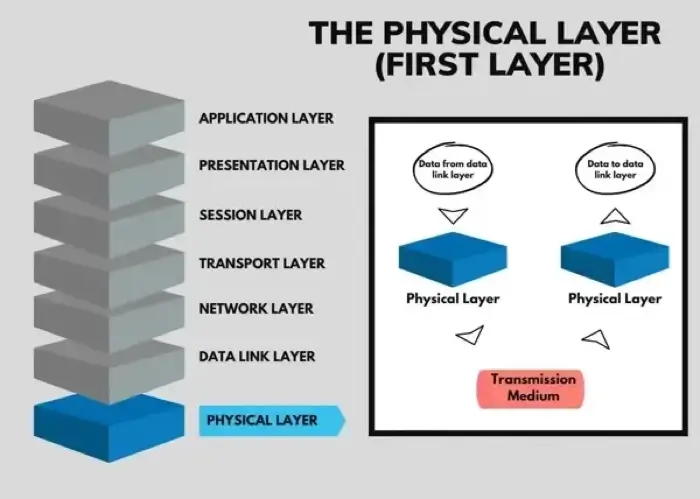A Guide to the Physical Layer | Layer 1 in the OSI Model
When troubleshooting network problems, the physical layer is typically the first place to start. The physical layer is the lowest layer in the Open Systems Interconnect (OSI) model of computer networking. In this article, learn how the physical layer of the OSI model is concerned with the physical connections of devices, how it operates, and its various functions.
What is the physical layer?
The physical layer, sometimes called the hardware layer, is the first layer in the OSI reference model. As the lowest layer, it’s closely associated with most of the network’s tangible connections – cabling, cabling types and standards, connectors, wireless transmissions, network interface cards, and more. The purpose of the OSI model physical layer is to transfer raw data bits across the physical medium, whether it be wired or wireless. Made up of both software and hardware, this layer is responsible for acting as a foundation for the most important functions.
In short, this layer is responsible for data transfer over a communication channel. It defines the electrical, functional, and procedural means to activate, maintain, and deactivate a physical link between end systems.

How does the physical layer work?
Before network communication takes place, you must establish a physical connection to a local area network (LAN). The OSI physical layer can check to see if these cables are properly connected, ensuring successful communication. The layer breaks the frames received from the data link layer into streams of 0s and 1s.
At the receiver end, the first layer receives data signals, splits them into bits, and passes them onto the next layer as frames. They then travel to the upper layers.
Functions of the physical layer
The physical layer, like other layers of the OSI model, is designed to perform a specific task. In this case, its main task is to transmit data across a connection, which requires electrical, mechanical, and procedural interfaces.
The main functions at the layer include:
- Synchronization. The layer performs synchronization of data bits. First, it ensures that both sending and receiving devices are linked, allowing data to transmit and be received in the correct order at the correct rate.
- Defining and transmitting bits. The layer provides the means to convert data bits from 0s and 1s. Aside from that, it determines how bits can transmit from the source over communications channels.
- Physical topology. Physical topology is the geographical representation of linking devices. Layer 1 defines the layout of devices and cables that make up the network, including the cable, cable pinouts, and connectors used.
- Data rate definition. How fast do data bits flow? Layer 1 defines the speed at which bits transmit over the physical link in bits per second.
- Clocking. The layer also comes up with a timing mechanism to coordinate data movement from one device to another.
- Signal encoding. The physical layer encodes the transferred data into signals that travel over the physical medium, like light and electrical signals.
- Line configuration. This defines the physical characteristics of the line, including the type of cable, number of wires, and connector used.
- Interface. The layer provides the transmission medium and devices. It also determines the number of network devices to connect.
Protocols in the physical layer
There are many protocols that control data transmission in the physical layer of networking. They include the following:
- Bluetooth
- Universal Serial Bus
- Controller Area Network
- 1000Base-T Ethernet
- 100BaseTX Ethernet
Though each of these protocols is unique, they all serve to facilitate data transmission across networks.
Device components of the physical layer
OSI model layer 1 is home to a variety of devices used to complete the layer’s functions. Cables and connectors, for example, are a crucial part of layer 1. Cables carry electromagnetic signals, transmitting them from source to destination. In layer 1, cables used include shield twisted pairs, unshielded twisted pairs, and coaxial cables.
Connectors, on the other hand, facilitate the joining of fiber or electrical cables and conductors. Connector types include fiber optic, USB, Ethernet, and many more. The physical layer also determines the shape and size of the connector.
NICs, or network interface cards, are a hardware component in the physical layer. They are typically in the form of circuit boards, which provide Internet-capable devices like computers with dedicated, full-time network connections.
Receivers and transmitters are also crucial to first layer of the OSI model. Receivers receive signals from the transmission system, whereas transceivers convert electrical signals to light signals and vice versa. They function as radio transmitters and receivers in a single package.
Frequently asked questions
Where is the physical layer located in the OSI model?
The physical layer is the lowest layer of the seven-layer model. It’s also called layer 1.
Is WiFi in the physical layer?
Yes; as a rule, WiFi operates at both the first and second layers of the OSI model.
What other layers are in the OSI model?
The other layers in the OSI model are the data link layer, the network layer, the transport layer, the session layer, the presentation layer, and the application layer.
What are three primary functions of the OSI model layer 1?
Three primary functions of the layer are synchronization, data encoding, and connection establishment.
What is the purpose of the OSI physical layer?
The purpose of the physical layer is essentially data transfer. The layer sends raw data across a physical medium, acting as a foundation for the most important functions and layers.